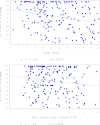Developmental function in toddlers with sickle cell anemia
- PMID: 23296434
- PMCID: PMC3557401
- DOI: 10.1542/peds.2012-0283
Developmental function in toddlers with sickle cell anemia
Abstract
Background: Neurocognitive impairment occurs in children and adults with sickle cell anemia, but little is known about neurodevelopment in very young children. We examined the neurodevelopmental status of infants participating in the Pediatric Hydroxyurea Phase III Clinical Trial (Baby Hug) to determine relationships with age, cerebral blood flow velocity, and hemoglobin concentration.
Methods: Standardized measures of infant neurodevelopment were administered to 193 infants with hemoglobin SS or hemoglobin S-β(0) thalassemia between 7 and 18 months of age at the time of their baseline evaluation. Associations between neurodevelopmental scores and age, family income, parent education, hemoglobin concentration, and transcranial Doppler velocity were examined.
Results: Mean functioning on the baseline neurodevelopment scales was in the average range. There were no mental development scores <70 (impaired); 22 children had scores in the clinically significant range, 11 with impaired psychomotor scores and 11 with problematic behavior rating scores. Significantly poorer performance was observed with older age at baseline. Behavior rating scores were an average of 2.82 percentile points lower per month of age, with similar patterns observed with parent report using adaptive behavior scales. Parent-reported functional abilities and hemoglobin were negatively associated with higher transcranial Doppler velocities.
Conclusions: Whereas overall functioning was in the normal range, behavioral and adaptive function was poorer with older age, even in this very young group of children. Explanatory mechanisms for this association between poorer developmental function and older age need to be identified.
Figures
References
-
- Armstrong FD, Thompson RJ, Jr, Wang W, et al. Neuropsychology Committee of the Cooperative Study of Sickle Cell Disease . Cognitive functioning and brain magnetic resonance imaging in children with sickle cell disease. Pediatrics. 1996;97(6 pt 1):864–870 - PubMed
-
- Bernaudin F, Verlhac S, Fréard F, et al. . Multicenter prospective study of children with sickle cell disease: radiographic and psychometric correlation. J Child Neurol. 2000;15(5):333–343 - PubMed
-
- Gold JI, Johnson CB, Treadwell MJ, Hans N, Vichinsky E. Detection and assessment of stroke in patients with sickle cell disease: neuropsychological functioning and magnetic resonance imaging. Pediatr Hematol Oncol. 2008;25(5):409–421 - PubMed
-
- Schatz J, Finke R, Roberts CW. Interactions of biomedical and environmental risk factors for cognitive development: a preliminary study of sickle cell disease. J Dev Behav Pediatr. 2004;25(5):303–310 - PubMed
-
- DeBaun MR, Schatz J, Siegel MJ, et al. . Cognitive screening examinations for silent cerebral infarcts in sickle cell disease. Neurology. 1998;50(6):1678–1682 - PubMed
Publication types
MeSH terms
Substances
Grants and funding
LinkOut - more resources
Full Text Sources
Other Literature Sources
Medical




